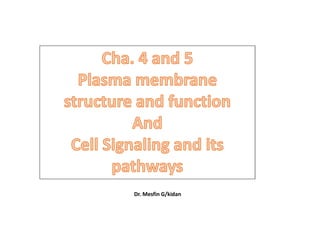
Membrane_and_Signaling_pathways_Lecture_Chap_4_and_5_recently_modified.pdf
- 13. Eg. O2, CO2, H2O, steroids Eg. Glucose, K+, Na+ and Charged ions
- 25. Prevents water and other dissolved ions leaking in and out of the cell i.e
- 53. Cell Signaling and receptor
- 54. Cell signaling is the fundamental process by which specific information is transferred from the cell surface to the cytosol and ultimately to the nucleus, leading to changes in gene expression. Not all cells can “hear” a particular chemical message. In order to detect a signal (that is, to be a target cell), a neighbor cell must have the right receptor for that signal. When a signaling molecule binds to its receptor, it alters the shape or activity of the receptor, triggering a change inside of the cell. Signaling molecules are often called ligands, a general term for molecules that bind specifically to other molecules (such as receptors). There are two types of receptors: Cell Signaling and receptor
- 56. Forms of signaling Cell-cell signaling involves the transmission of a signal from a sending cell to a receiving cell. However, Not all sending and receiving cells are next-door neighbors, nor do all cell pairs exchange signals in the same way. There are four basic categories of chemical signaling found in multicellular organisms: I. Autocrine signaling, II. Paracrine signaling III. Endocrine signaling, and IV. Signaling by direct contact. The main difference between the different categories of signaling is the distance that the signal travels through the organism to reach the target cell.
- 57. I. Autocrine signaling In autocrine signaling, a cell signals to itself, releasing a ligand that binds to receptors on its own surface (or, depending on the type of signal, to receptors inside of the cell). Autocrine signaling plays an important role in many processes. For instance, autocrine signaling is important during development, helping cells take on and under go cell division and regeneration of tissues. From a medical standpoint, autocrine signaling is important in cancer and is thought to play a key role in metastasis (the spread of cancer from its original site to other parts of the body).
- 59. II. Paracrine signaling Often, cells that are near one another communicate through the release of chemical messengers (ligands that can diffuse through the space between the cells). This type of signaling, in which cells communicate over relatively short distances, is known as paracrine signaling. One unique example of paracrine signaling is synaptic signaling, in which nerve cells transmit signals. This process is named for the synapse, the junction between two nerve cells where signal transmission occurs.
- 60. When the impulse reaches the synapse, it triggers the release of ligands called neurotransmitters, Which quickly cross the small gap between the nerve cells. When the neurotransmitters arrive at the receiving cell, they bind to receptors and cause a chemical change inside of the cell That lead to opening ion channels and changing the electrical potential across the membrane). Cont……
- 64. III. Endocrine signaling When cells need to transmit signals over long distances, they often use the circulatory system as a distribution network for the messages they send. In long-distance endocrine signaling, signals are produced by specialized cells and released into the bloodstream, which carries them to target cells in distant parts of the body. Signals that are produced in one part of the body and travel through the circulation to reach far-away targets are known as hormones. For example: In humans, endocrine glands that release hormones include the thyroid, the hypothalamus, and the pituitary, as well as the gonads (testes and ovaries) and the pancreas.
- 66. Each endocrine gland releases one or more types of hormones, many of which are master regulators of development and physiology. For example, the pituitary gland releases growth hormone (GH), which promotes growth, particularly of the skeleton and cartilage. Like most hormones, GH affects many different types of cells throughout the body. However, cartilage cells provide one example of how GH functions: Ìt binds to receptors on the surface of these cells and encourages them to divide Cont…..
- 68. IV. Signaling through cell-cell contact Gap junctions in animals and plasmodesmata in plants are tiny channels that directly connect neighboring cells. These water-filled channels allow small signaling molecules, called intracellular mediators, to diffuse between the two cells. Small molecules and ions are able to move between cells, but large molecules like proteins and DNA cannot fit through the channels without special assistance.
- 69. In another form of direct signaling, two cells may bind to one another because they carry complementary proteins on their surfaces. When the proteins bind to one another, this interaction changes the shape of one or both proteins, transmitting a signal. This kind of signaling is especially important in the immune system, where immune cells use cell- surface markers to recognize “self” cells (the body's own cells) and cells infected by pathogens
- 86. Gs and Gi activities during signaling
- 90. Termination of cAMP and dephosphorylating of glycogen
- 91. Gi (G protein Inhibition)
- 93. Gi (G protein Inhibition)
- 95. Glycogen to Glu. Glu to ATP
- 100. Diagrammatic abstract how the IP3 and DAG formed
- 101. Diagrammatic abstract how the IP3 and DAG work
- 102. Cont………
- 103. Mechanism of PLC Pathway (serotonin)
- 125. Inaddition o bloking